There are 3.8 billion people using social media today—more people than there were on the entire planet in 1971. In 2020, 3.8 billion is nearly half the world’s population.
This figure comes from the Digital 2020 report from Hootsuite and We Are Social, which tracks digital and social media trends across the globe. Here are the top three stats from the report:
- 321 million new people joined social media in 2019, which brought the total from 3.48 billion to 3.8 billion social media users (an increase of 9%) in 2020
- 4.5 billion people now use the internet, an increase of 298 million new users (or 7%) year-on-year
- There are more than 5.19 billion mobile phone users, up 2.4% year-on-year (or 124 million new users)
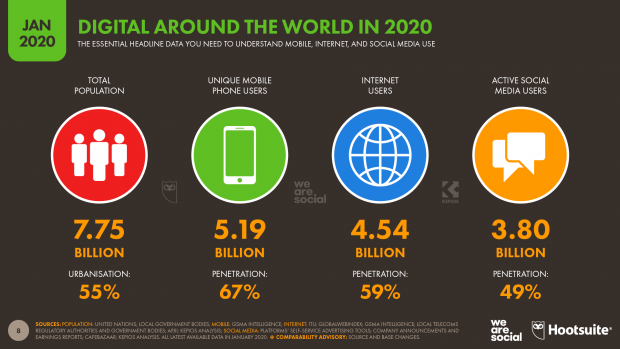
A big thank you to the data partners who contributed to this year’s reports, including:
The full Digital 2020 report dives into detailed data on global online habits and demographics. Here are some of the most important headlines for social media professionals to know.
Download the complete Digital 2020 report to learn where to focus your social marketing efforts and how to better target your audience. The full study also includes more easy-to-understand data visualizations and shareable graphics.
Sommaire
We spend an average of two hours and 24 minutes per day using social media
People spent 1.75 trillion hours using mobile phones over the past 12 months. And they spent roughly half that time using social and communications apps.
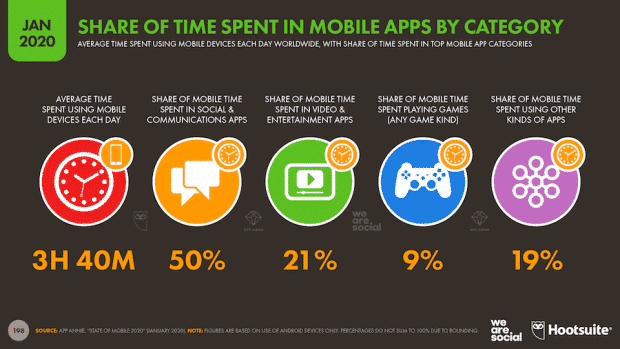
GlobalWebIndex reports that we now spend an average of two hours and 24 minutes per person, per day using social media. That’s an increase of two minutes per day since this time last year.
Once again, the story varies by country. Filipinos are still the world’s most ‘social’ people, with the average internet user aged 16 to 64 spending almost four hours per day on social platforms.
On the other end of the scale, internet users in Japan spend an average of only 45 minutes per day on social media.
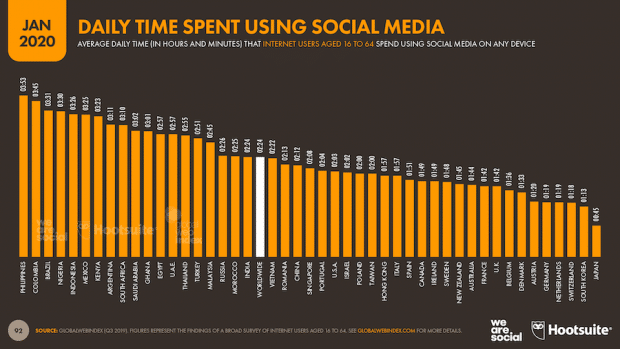
Facebook still dominates
Despite various challenges over the past few years, Facebook is still topping the charts when it comes to social. User numbers continued to grow steadily across most countries during 2019.
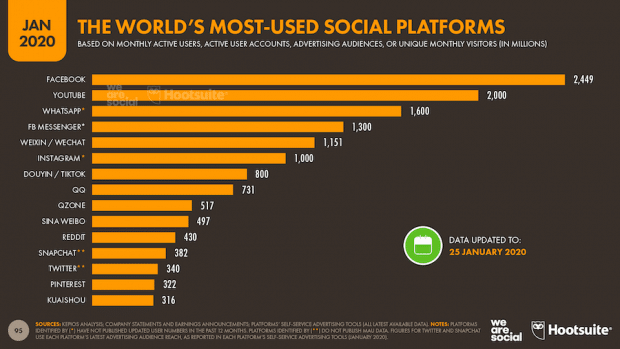
But, for various reasons, marketers can’t reach all of these users using Facebook advertising. The platform’s own self-service advertising tools indicate that the total addressable Facebook audience now stands at 1.95 billion, or roughly 80% of total MAUs.
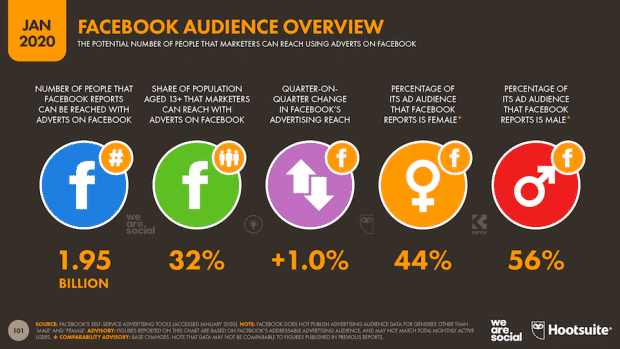
Facebook has seen a few audiences decline over the past year too. Its self-service advertising tools reported lower reach figures for India, Spain, and South Korea at the end of 2019.
Overall though, Facebook’s total audience reach has still grown by 1% in the past 3 months.

Most importantly, marketers can now use Facebook to reach one-third of all the world’s adults aged 18 and above, and more than half of all the world’s adults aged 18 to 34. That’s despite the platform still being blocked in China.
TikTok is the sixth largest social network now
TikTok was probably the media’s top social story in 2019, with some huge (and often misrepresented) numbers hitting the headlines. But, a TikTok advertising sales deck leaked by AdAge a couple of months ago offers more clarity.
First up, there’s no denying it: TikTok is big. It has 800 million monthly active users.
But, 500 million of these active users (more than 60% of the total) live in China. That means that the platform has roughly 300 million monthly active users in the rest of the world.
Similarly, the latest data from App Annie suggest that Chinese users account for 80% of the total time spent using TikTok in 2019. Users in India accounted for a further 10%. That means China and India are responsible for roughly nine out of every 10 minutes spent using TikTok around the world.
That’s already enough to put TikTok in sixth place in the global app rankings by monthly active users in 2019.
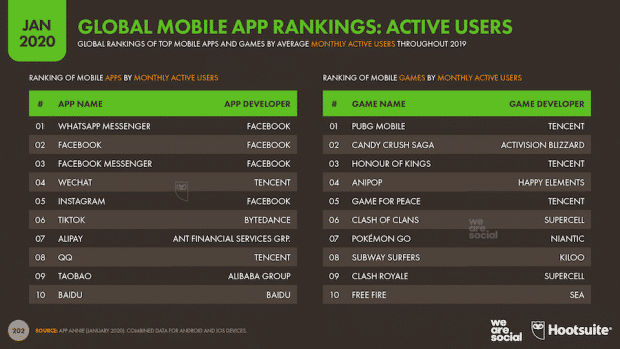
But, it’s important to stress that TikTok’s popularity has not come at the expense of any of the other Western platforms. In fact, Facebook, Instagram, and Snapchat have all reported increases in their advertising audience reach over the past few months, even amongst users aged 13 to 17.
Reddit, Pinterest, and Sina Weibo are growing fast too
Reddit’s monthly active user numbers have surged by 30% (100 million new users) since this time last year. The company’s latest reports reveal that the platform now attracts 430 million users each month.
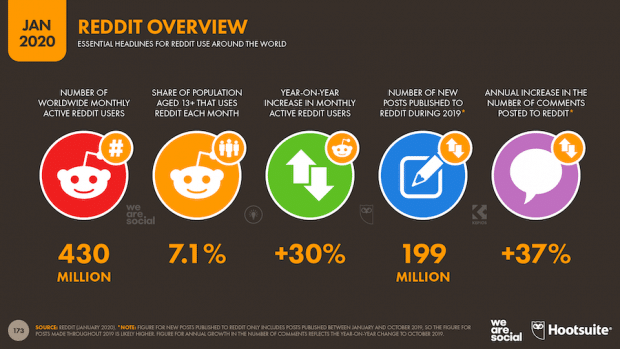
Pinterest has enjoyed similar success, growing its active user base by 29% over the past year. The platform has attracted more than 70 million new monthly active users (MAUs) over the past 12 months for a total of 322 million MAUs.
The company has also added a number of new countries to its advertising targeting options, resulting in a quarter-on-quarter increase in potential advertising reach of 12% between October 2019 and January 2020.
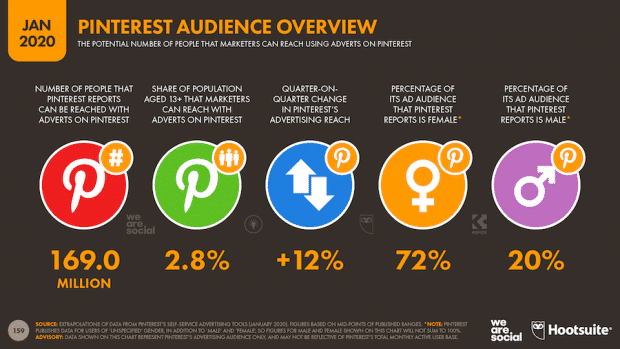
Sina Weibo has also been enjoying impressive growth. Recent trends suggest that the platform’s MAU numbers should pass the half-billion mark within the next few months.
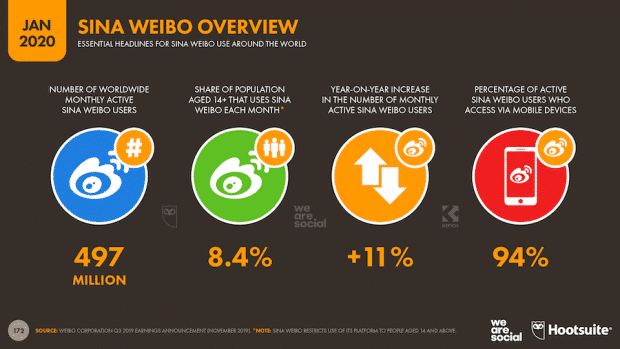
There is a digital gender gap, and it applies to social media too
Worldwide, women are 28% more likely to be ‘unconnected’ to the internet than men. This imbalance is even greater in Southern Asia, where women are 2.4 times more likely to be ‘unconnected’ than men.
The digital gender gap is apparent in our latest social media data too. Women in Southern Asia are three times less likely to use social media today compared to men. And on average, 55% of men use social media compared to 45% of women.
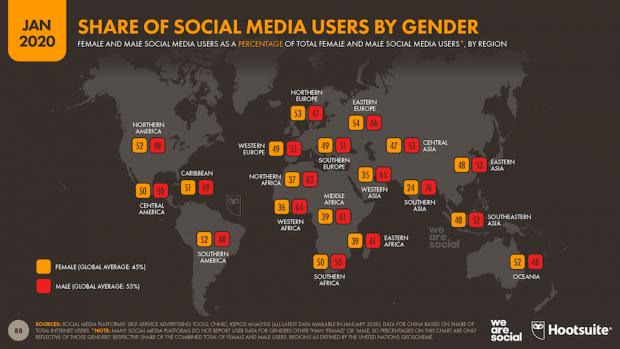
Even more worryingly, research from GSMA Intelligence suggests that more than half of all women living in India today are unaware of the existence of mobile internet.
The United Nations reports that much of this imbalance stems from “deeply ingrained social norms and practices.” Regardless of the cause, however, connecting the unconnected will depend heavily on improving digital accessibility for women, especially in developing economies
27% of internet users discover new products through social media ads
Overall, GlobalWebIndex reports that search engines are the primary source of discovery for new brands and products, slightly ahead of television adverts. But, younger users are more likely to turn to social media when they’re actively researching brands and products.

The same report says 43% of internet users around the world aged 16 to 64 now say that they use social networks when researching things to buy.
But, social commerce hasn’t caught on to the extent that many marketers might have hoped. As GlobalWebIndex stated in their recent Commerce trends report,
“While social networks often play a central role in the initial steps on the path to purchase, only 12% of internet users say that a ‘buy’ button on a social network would drive them to check-out online.”
Marketers should consider the full scope of the consumer purchase cycle—from initial discovery through to purchase, and even post-purchase activities—when devising their plans.
The most used emoji on Twitter is the laughing crying face
Not much to say about this here, except that people laughed a lot on Twitter this year.
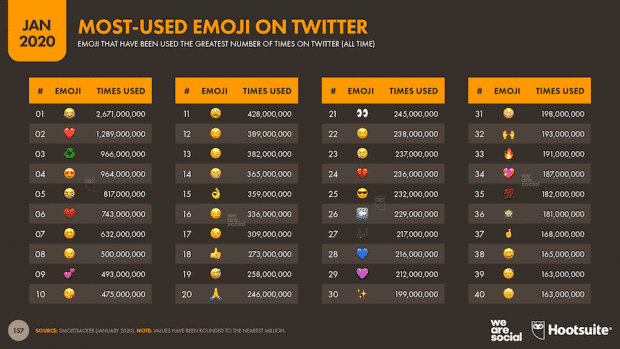
Download the complete Digital 2020 report to learn where to focus your social marketing efforts and how to better target your audience. The full study also includes more easy-to-understand data visualizations and shareable graphics.
This is an edited version of Simon’s complete Digital 2020 analysis, which you can read in full over on DataReportal.
